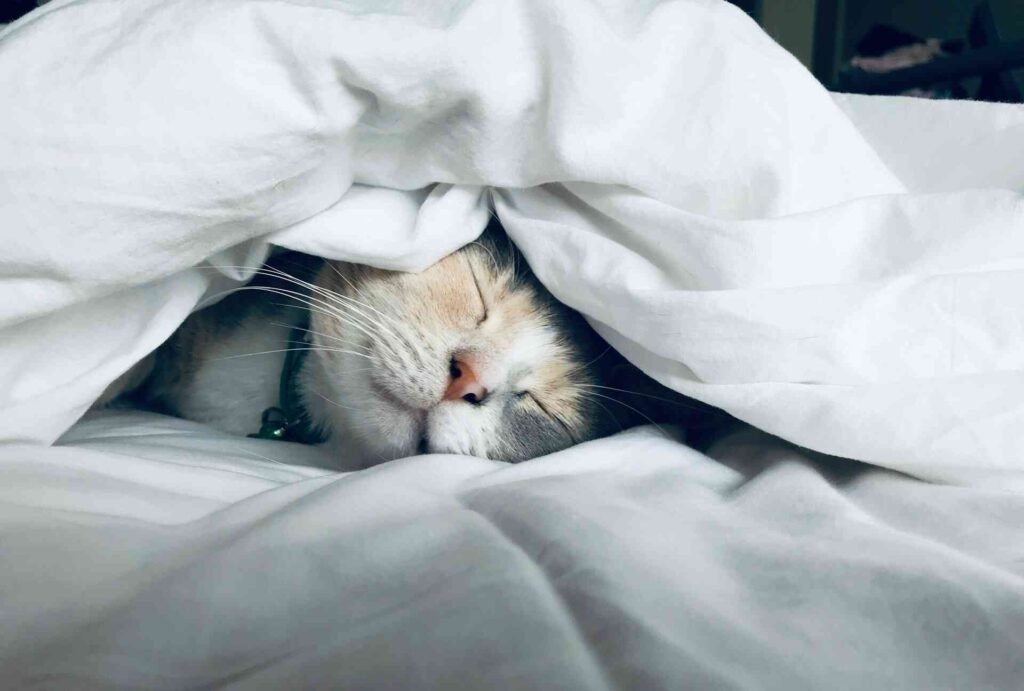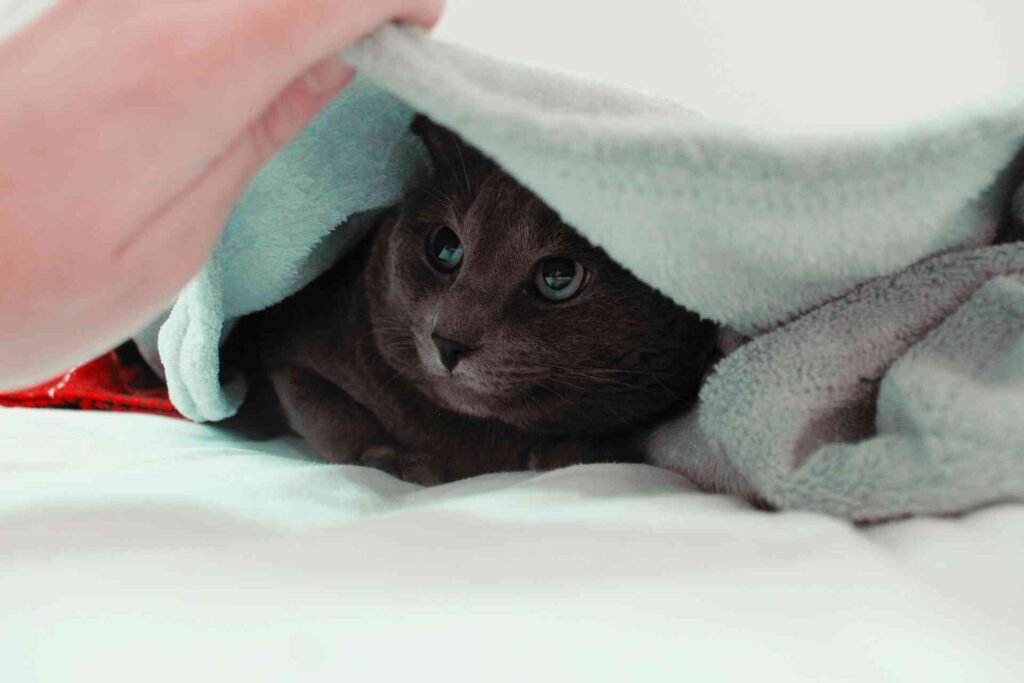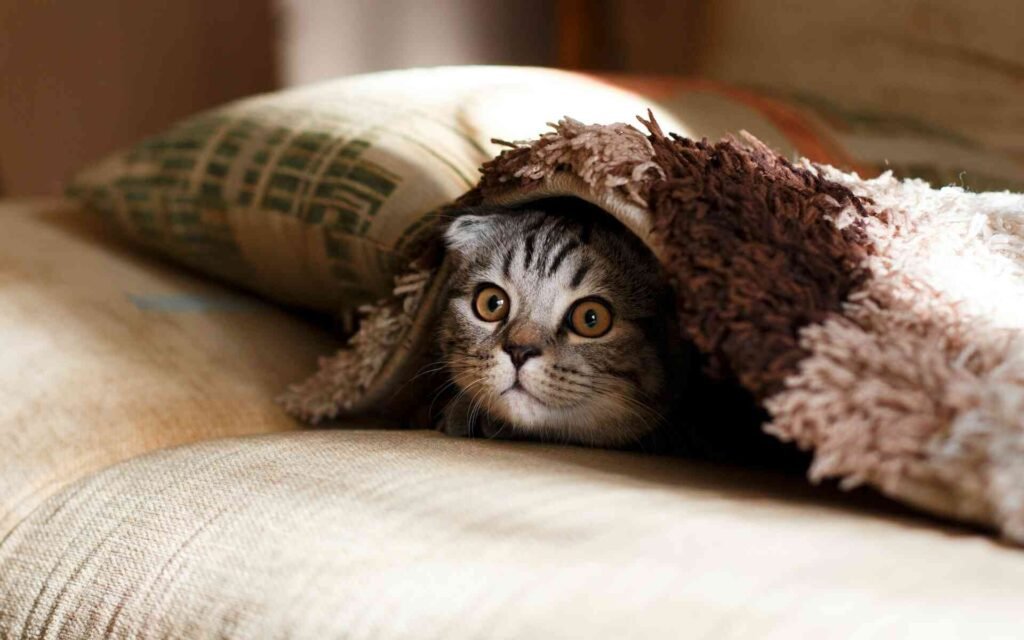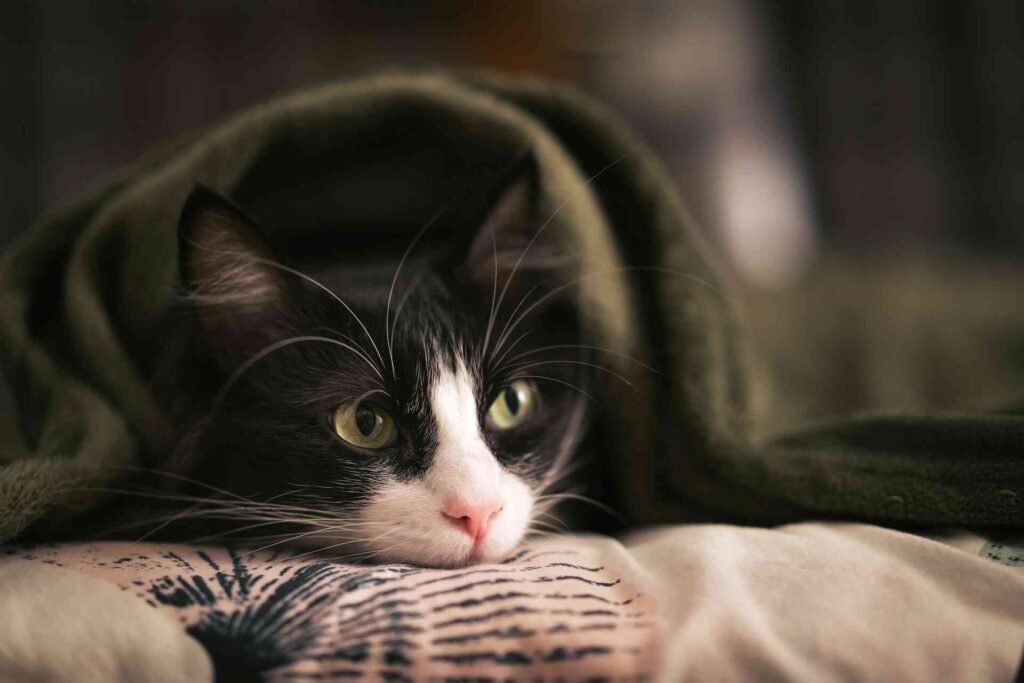Picture this: you’re settling in for the evening when you notice a suspicious lump moving under your favorite throw blanket. You lift the corner to find your cat’s bright eyes staring back at you from their makeshift fortress. If you’ve ever wondered why your feline friend has suddenly developed an obsession with hiding under blankets, you’re not alone. This endearing yet puzzling behavior has countless cat parents scratching their heads and asking the same question.
The truth is, when your cat hides under blankets, they’re following deeply ingrained instincts that have kept their species safe and comfortable for thousands of years. Understanding these motivations can help you better appreciate your furry companion’s quirky habits and ensure they’re getting everything they need to feel secure and content in your home.

The Comfort Zone: Why Cats Seek Out Cozy Hideaways
Cats are natural den animals, meaning they instinctively seek out small, enclosed spaces where they feel protected from potential threats. In the wild, cats would find shelter in caves, hollow logs, or dense vegetation. Your modern house cat has simply adapted this ancient behavior to work with contemporary amenities, like your soft, warm blankets.
When we observe our cats gravitating toward these cozy hiding spots, we’re witnessing millions of years of evolution at work. The blanket becomes their personal sanctuary, offering the same sense of security their ancestors found in natural shelters. This behavior is so fundamental that it appears across all domestic cat breeds, regardless of their living environment.
The appeal goes beyond just safety, though. Blankets provide the perfect combination of warmth, darkness, and enclosure that cats find irresistible. Think of it as nature’s original anxiety relief system, a built-in coping mechanism that helps cats regulate their stress levels and feel more in control of their environment.
Temperature Regulation: The Science Behind the Snuggle
One of the most practical reasons cats hide under blankets relates to their unique relationship with temperature. Unlike humans, cats have a higher baseline body temperature, typically ranging between 100.5 and 102.5 degrees Fahrenheit. However, they can still feel cold, especially in air-conditioned homes or during cooler months.
Blankets act as perfect insulators, trapping your cat’s body heat and creating a warm microenvironment. This is particularly important for cats because they lose heat quickly through their extremities, their ears, paws, and nose. By burrowing under covers, they’re essentially creating their own personal heating system.
Senior cats and kittens are especially drawn to this behavior because their bodies are less efficient at regulating temperature. If you notice your cat suddenly hiding under blankets more frequently, it might be worth checking if your home temperature has dropped or if your feline friend is experiencing any age-related changes that make them seek extra warmth.
The thermal comfort factor also explains why many cats prefer certain types of blankets over others. Fleece, wool, and other insulating materials are often favorites because they retain heat more effectively than cotton or linen.
Stress and Anxiety: When Hiding Becomes a Coping Mechanism
Sometimes, the reason your cat keeps hiding under blankets has less to do with physical comfort and more to do with emotional well-being. Cats are incredibly sensitive to changes in their environment, and even minor disruptions can trigger stress responses that send them seeking shelter.
Common stressors that might cause increased blanket-hiding behavior include:
- New pets or family members in the household
- Loud noises from construction, thunderstorms, or fireworks
- Changes in daily routine or feeding schedules
- Rearranged furniture or home renovations
- Illness or discomfort

When cats feel overwhelmed, retreating to a safe, enclosed space helps them regain their composure. The blanket becomes their reset button, a place where they can decompress and process whatever is causing them anxiety. This is why you might notice signs your cat is bored or stressed coinciding with increased hiding behavior.
It’s important to note that while occasional blanket hiding is perfectly normal, excessive hiding accompanied by other behavioral changes might indicate underlying health issues or chronic stress that requires attention.
The Security Blanket Effect: Creating Safe Spaces
Much like human children who find comfort in security blankets, cats develop strong attachments to specific hiding spots that make them feel protected. Your cat’s chosen blanket becomes associated with positive feelings of safety and relaxation, creating a powerful psychological anchor in their daily routine.
This attachment often explains why cats have preferences for certain blankets, beds, or even specific locations within your home. They’re not just seeking any warm spot, they’re returning to their established safe haven where they know they can let their guard down completely.
The security aspect becomes even more pronounced in multi-pet households. When resources like food, water, or attention feel competitive, cats may retreat to their blanket hideaways to avoid conflict and maintain their sense of territory.
Age-Related Factors: From Kitten to Senior
The tendency to hide under blankets often varies significantly with age, and understanding these patterns can provide valuable insights into your cat’s changing needs.
Kittens are naturally drawn to enclosed, warm spaces that remind them of the security they felt with their mother and littermates. A kitten hiding under blankets is often recreating that cozy, protected feeling they experienced in their early weeks of life. This behavior typically decreases as they grow more confident and independent, though some cats maintain the habit throughout their lives.
Adult cats usually develop more selective hiding patterns, often triggered by specific circumstances like stress, illness, or environmental changes. Their blanket-hiding behavior tends to be more purposeful and temporary compared to the more constant seeking behavior seen in kittens.
Senior cats frequently return to increased blanket-seeking behavior as they age. Older cats often feel colder due to decreased circulation and may experience joint pain that makes soft, cushioned spaces more appealing. Additionally, cat sleeping positions can change with age, with many seniors preferring more protected, enclosed sleeping arrangements.
Health Considerations: When to Pay Attention
While hiding under blankets is generally harmless and often beneficial for cats, there are certain situations where this behavior might indicate health concerns that warrant closer attention.
Sudden changes in hiding patterns can sometimes signal medical issues. If your previously social cat suddenly starts spending entire days hidden under blankets, or if a cat who never hid before begins seeking constant shelter, these changes could indicate pain, illness, or sensory issues.

Temperature regulation problems, particularly in older cats, might manifest as increased blanket-seeking behavior. Conditions affecting circulation, metabolism, or joint health can make cats feel constantly cold, driving them to seek additional warmth more frequently than normal.
It’s also worth monitoring your cat’s behavior when they emerge from their blanket hideaway. Healthy cats should still maintain their normal eating, drinking, and social behaviors. If blanket hiding is accompanied by decreased appetite, lethargy, or avoidance of normal activities, it’s wise to consult with your veterinarian.
Creating the Perfect Environment for Your Blanket-Loving Cat
Understanding why your cat hides under blankets opens up opportunities to enhance their comfort and well-being. Rather than discouraging this natural behavior, you can work with it to create an environment that supports your cat’s instinctual needs.
Consider designating specific blankets as “cat blankets” that remain accessible throughout your home. Fleece throws, heated pet blankets, or even old towels can become designated comfort items that your cat can claim as their own. This approach prevents the frustration of finding cat hair on your best linens while ensuring your feline friend always has access to their preferred hiding spots.
Placement strategy matters significantly. Cats prefer hiding spots that offer multiple escape routes and good vantage points. Avoid placing blankets in high-traffic areas or corners where your cat might feel trapped. Instead, choose locations that allow them to observe their surroundings while remaining concealed.
The type of blanket material can also impact your cat’s preferences. Natural fibers like wool tend to retain heat better, while synthetic materials like fleece are often softer and more cushioning. Experiment with different textures and weights to discover what your cat prefers, keeping in mind that individual preferences can vary significantly.
Normal vs. Concerning Behavior Patterns
Learning to distinguish between normal blanket-hiding behavior and potentially problematic patterns is crucial for responsible pet ownership. Here’s a helpful comparison to guide your observations:
| Normal Behavior | Potentially Concerning |
|---|---|
| Hiding for 2-4 hours at a time | Remaining hidden for entire days |
| Emerging for meals and social interaction | Avoiding food, water, or litter box |
| Responsive when gently called or approached | Completely unresponsive or fearful |
| Maintaining normal grooming habits | Neglecting personal hygiene |
| Playing and engaging when not hiding | Complete loss of interest in activities |
This comparison can help you determine when your cat’s blanket-hiding behavior falls within normal parameters versus when it might indicate underlying issues requiring professional attention.
Remember that every cat has their own personality and comfort levels. Some naturally introverted cats may spend more time hiding than social butterflies, and this variation is perfectly normal as long as their basic needs are being met.
Multi-Cat Households: Navigation and Territory
In homes with multiple cats, blanket-hiding behavior can take on additional complexity related to social dynamics and territory management. Each cat needs access to their own safe spaces, and competition for prime hiding spots can sometimes create tension.
Providing multiple blanket options throughout your home helps prevent resource guarding and ensures every cat has access to comfort when they need it. This is particularly important during stressful periods or when introducing new pets to the household.
Some cats may also use blanket hiding as a way to avoid unwanted social interaction with other household pets. This isn’t necessarily problematic, it’s often a healthy coping strategy that helps maintain harmony in multi-pet environments.
Seasonal Patterns and Environmental Factors
Many cat owners notice that their pet’s blanket-hiding behavior follows seasonal patterns, intensifying during colder months and decreasing when temperatures rise. This natural fluctuation reflects your cat’s adaptive responses to environmental changes.

During winter months, even indoor cats can sense temperature drops and adjust their behavior accordingly. Shorter daylight hours may also influence their desire to seek out cozy, dark spaces for extended rest periods. This seasonal variation is completely normal and often correlates with changes in sleep behaviors and dreaming patterns.
Summer hiding might be less about warmth and more about finding cool, dark retreats from bright sunlight or busy household activity. Understanding these seasonal preferences can help you anticipate your cat’s needs and adjust their environment accordingly.
Creating Positive Associations with Blanket Time
Rather than viewing your cat’s blanket-hiding as antisocial behavior, consider it an opportunity to strengthen your bond through respect for their natural instincts. You can create positive associations by occasionally offering treats or gentle pets when your cat emerges from their hiding spot, reinforcing that their safe space is truly secure.
Some cats enjoy having their favorite blanket moved to different locations throughout the day, giving them variety while maintaining the comfort of familiar scents and textures. Others prefer consistency and may become stressed if their established hiding spots are disrupted.
Pay attention to your cat’s preferences and try to accommodate them when possible. This might mean adjusting your cleaning schedule to avoid disturbing favorite hiding spots during peak rest times, or it might involve investing in washable blankets that can maintain cleanliness without disrupting your cat’s routine.
Frequently Asked Questions
Is it normal for my cat to hide under blankets all day
Extended blanket hiding can be normal for some cats, especially during cold weather or stressful periods. However, if your cat is avoiding normal activities like eating, drinking, or using the litter box, this could indicate illness or significant stress that requires attention.
Should I worry if my cat suddenly started hiding under blankets
Sudden changes in behavior always warrant attention. While starting to hide under blankets isn’t necessarily concerning, consider what else might have changed in your cat’s environment. New stressors, health issues, or seasonal changes could all trigger this new behavior.
Can hiding under blankets be dangerous for cats
Generally, blanket hiding is safe for cats. They have excellent spatial awareness and will emerge if they need air or feel too warm. However, very young kittens should be supervised to ensure they don’t become tangled or overheated.
How can I tell if my cat is hiding due to illness
Watch for accompanying symptoms like changes in appetite, litter box habits, grooming behavior, or responsiveness. Healthy cats should still engage with their environment when they’re not hiding. If you notice multiple behavioral changes alongside increased hiding, consult your veterinarian.
Do certain cat breeds hide under blankets more than others
While the instinct to seek enclosed spaces is universal among cats, some breeds with thinner coats or more anxious temperaments may be more inclined to blanket hiding. However, individual personality typically matters more than breed characteristics.
Embracing Your Cat’s Natural Instincts
Understanding why your cat hides under blankets reveals the beautiful complexity of feline behavior and the ways our domestic companions have adapted their wild instincts to modern life. Rather than seeing this behavior as problematic, we can appreciate it as a window into our cats’ emotional and physical needs.
By providing appropriate hiding opportunities, respecting their need for safe spaces, and monitoring for any concerning changes, we can support our cats’ natural behaviors while ensuring their health and happiness. Whether your feline friend is seeking warmth, security, or simply a quiet moment away from the hustle and bustle of household life, their blanket-hiding behavior is likely a sign of a cat who feels comfortable enough in their environment to let their guard down.
The next time you discover that telltale lump under your favorite throw, take a moment to appreciate the trust your cat is showing by choosing your home as their sanctuary. Their blanket fortress isn’t just a hiding spot; it’s a testament to the safe, loving environment you’ve created together. Remember that understanding your pet’s unique personality and respecting their individual needs is one of the most meaningful ways to strengthen the bond you share.
Every cat is unique, and their relationship with blanket hiding will reflect their individual personality, health status, and life experiences. By staying attentive to their patterns and responsive to their needs, you’re providing the kind of thoughtful care that helps cats thrive in their human families while honoring the wild instincts that make them such fascinating companions.
Looking for more? Explore our Cat Health section for more posts like this, visit the Blog for fun and insightful reads, or browse our full Cat Category for everything feline-related, from care to comfort.
Disclaimer: This article is for informational purposes only and does not substitute for professional veterinary advice. Always consult your veterinarian for diagnosis and treatment tailored to your cat’s individual needs. Please verify current product information directly on the retailer’s site before purchasing.
References
- Tammy Hunter, Malcolm Weir, MSc, MPH; Ernest Ward. (2023). Fever of Unknown Origin in Cats. https://vcahospitals.com/know-your-pet/fever-of-unknown-origin-for-cats
Check out our most recent articles!
- Cats and Snow: Why Some Love It and Others Don’tSnow isn’t just uncomfortable for many cats, it’s a complete sensory overload. From cold paw pads to wet fur and changed landscapes, winter challenges feline comfort in unexpected ways. Learn how to recognize stress signals and create cozy alternatives for snow-averse cats.
- Christmas Names for Cats: From Classic to Creative Holiday IdeasNaming your holiday cat goes beyond festive fun. Discover why Christmas-inspired names age beautifully, spark instant connections with fellow pet lovers, and capture the warmth cats bring to our homes during the most magical season of the year.
- How to Keep Your Cat From Drinking Christmas Tree WaterYour cat’s obsession with Christmas tree water isn’t just annoying, it’s genuinely dangerous. From harmful bacteria to toxic additives, that festive reservoir poses real health risks. Discover practical solutions that protect your pet without sacrificing holiday cheer.
- Best Cat Toys for Christmas: The Ultimate Guide to Holiday JoyNot all Christmas gifts end up under the tree, some get batted across the floor at 3 AM. Explore the wonderful world of holiday cat toys that match your feline’s personality, from plush companions for cuddlers to high-tech options for the eternally energetic.
- Are Fake Christmas Trees Safe for Cats? A Holiday Safety GuideThat beautiful Christmas tree might look festive to you, but to your cat, it’s an irresistible climbing gym with built-in toys. Find out whether artificial trees are truly safer for cats and discover the hidden dangers lurking in your holiday decorations.
- The Best Christmas Gifts for Cats That’ll Actually Get Used (Not Ignored)Not all Christmas gifts land on the nice list with our feline friends. Discover which presents actually spark joy in cats and which ones end up gathering dust under the couch by New Year’s Day.
- Do Cats Eat Less in Winter? How Cold Weather Affects Your Cat’s AppetiteWinter brings more than just cold weather, it can completely change your cat’s eating habits. From bored indoor cats to outdoor ferals fighting to survive, discover what’s really driving those appetite changes and how to respond appropriately.
- Are Humidifiers Good for Cats? A Complete Safety & Health GuideNot all humidifiers are cat-safe, and some common practices could be toxic. Learn why cool mist beats warm mist, why essential oils are dangerous for felines, and how proper humidity levels between 30-50% support your cat’s breathing and coat health.
- How to Protect Leather Furniture From Cats (Without Losing Your Mind)Leather furniture and cat claws seem like natural enemies, but they don’t have to be. Learn why your cat is drawn to that expensive couch in the first place, and how simple redirects can save your furniture while keeping your cat’s natural behaviors satisfied.
- The Best Material for Cat Bowls: Protect Your Cat from BacteriaStainless steel, ceramic, or plastic, which material keeps your cat healthiest? We break down the science behind cat bowl materials, revealing why some harbor bacteria and others last decades without compromising your feline’s wellbeing.










